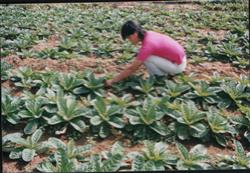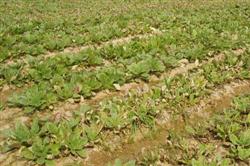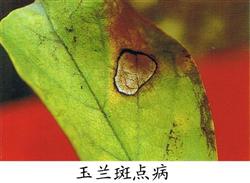How to grow Rehmannia glutinosa?

How to grow Rehmannia glutinosa? Please give a detailed introduction to the planting method of Rehmannia glutinosa, also known as Rehmannia glutinosa, raw and cooked land, which belongs to the genus of Scrophulariaceae. It has the effect of nourishing yin and clearing heat, stopping bleeding and tonifying blood. It mainly treats Yin deficiency, blood deficiency, tinnitus, waist and knee pain and so on. The pollution-free cultivation techniques are introduced as follows: 1. Land selection and land preparation: planting Rehmannia glutinosa should choose sandy loam with deep soil layer, loose fertility and good drainage, turn 25cm deep before winter, and apply fully mature high quality ring fertilizer 3500004500kg per 667 square meters (1 mu), calcium superphosphate 25kg, turn it into the soil as base fertilizer. After fertilization, leveling and raking fine, made into 1.3 meters wide high border planting, border ditch width of 40 cm, surrounded by a large drainage ditch to facilitate drainage. two。 Planting: the planting period of Rehmannia glutinosa varies according to different climatic conditions and planting methods. Before planting, cut off the head and tail of the seed, take its middle section, and then cut it into small segments 4-6 cm long, each with 2-3 bud eyes, the incision is dipped in plant ash, slightly dried before planting. Planting density: row spacing 30 cm 40 cm, plant spacing 27 cm 33 cm. Dig shallow holes 3-5 cm deep on the finished border surface, plant 1-2 sections horizontally in each hole, cover a handful of soil ash, and then cover fine soil flush with the border surface. It is necessary to plant 30kg and 40kg per 667 square meters. 3. Field management: (1) replenishing seedlings. When the height of the seedling is 10 cm to 12 cm, start the seedling, and leave 1 strong seedling in each hole. In case of lack of seedlings, choose cloudy days to replant in time, in order to improve the survival rate, make up seedlings with soil. (2) weeding by ploughing. The rhizome of Rehmannia glutinosa is shallowly buried in the soil, the middle tillage should be shallow so as not to hurt the root, the weeds around the seedlings should be pulled out by hand, and the middle tillage should be stopped after the ridge is closed. (3) topdressing. Rehmannia glutinosa likes fertilizer, in addition to adequate base fertilizer, but also fertilize 3 times a year. For the first time, 2500 kg of rotten human and animal feces and 50 kg of rotten cake fertilizer were applied every 667m2 to promote strong seedlings. The seedlings were fertilized for the second time when the seedling height was 10 cm. Every 667 square meters, 2500-3000 kg of fully mature human and animal manure, 30 kg of rotten cake fertilizer and 100 kg of superphosphate were applied to promote the expansion of the rhizome. The third fertilizer was applied when the row was closed, and the fiery soil ash was applied once between the rows to promote the plant growth and health. (4) drainage and irrigation. Watering should be performed in the early stage, and watering should be controlled in the later stage. It is necessary to dig drains and drain them in time to prevent the occurrence of root rot. In case of drought or after each topdressing, water it in time. (5) picking buds and removing tillers. Plant bolting should be cut off in time. The tillers around the root system should be cut off from the root in time to promote the growth of the underground. (6) except for string skin root. In addition to the main root, Rehmannia glutinosa also grows slender underground stems along the surface, which are also called bark roots, which consume a lot of nutrients and should be eradicated in time. 4. Pest control: when spot blight occurs, 65% mancozeb wettable powder is sprayed 500 times. In order to make Rehmannia glutinosa reach the pollution-free standard, mancozeb is used no more than 3 times during the whole growing period. For the occurrence of ring disease, spray 75% chlorothalonil wettable powder 600 times, up to 3 times a season. When aphids occur, use 50% aldicarb wettable powder 500 times liquid spray to control aphids, up to 3 times a season. 5. Harvest and processing: (1) harvesting. When the aboveground stems and leaves are yellow and spotted, dig in time, cut off the stems and leaves first, then open a ditch 35 cm deep at one end of the border, and carefully dig the roots in turn. (2) processing. First, remove the fibrous root of fresh Rehmannia glutinosa, according to the classification of large, medium, small, medium and small, put it on the hot Kang to dry. Start using martial fire to raise the temperature to 80-90 ℃. 8 hours later, when the local corpus luteum is soft and unhardened, take out the pile and cover it with gunny bags or straw to make it "sweat". Return to the Kang 5-7 days later, the temperature is 50-60 ℃, Kang 6-8 hours, until the color gradually blackens, dry and soft, that is, Rehmannia glutinosa. Soak the raw Rehmannia glutinosa in yellow rice wine, stew the yellow rice wine with fire, and then dry it in the sun, which is called cooked Rehmannia glutinosa. Generally, it produces more than 3000 kilograms of fresh Rehmannia glutinosa per 667m2, with no Reed head, large block, weight and black cross-section as the best. Click to get more planting techniques of Rehmannia glutinosa
- Prev

How to cultivate Rehmannia glutinosa?
How to cultivate Rehmannia glutinosa? Is there a technical introduction to the cultivation of Rehmannia glutinosa? The cultivation of Rehmannia glutinosa can be planted with reference to the following methods: first, land selection and soil preparation. It is appropriate to choose sandy loam with deep, fertile and good drainage. Dig the soil more than 25 cm deep in the first winter or early spring and apply mature compost 2000-3000 per mu at the same time.
- Next

How to prevent and cure magnolia spot disease?
How to prevent and cure magnolia spot disease? Please give guidance on Magnolia spot disease: first, symptoms: also known as brown spot, leaf spot, mainly harmful to leaves. Primary yellow to light brown dots, then expanded into nearly round to irregular spots, edges with reddish-brown lines, gray-white in the middle, black dots scattered in the later part of the disease.
Related
- Fuxing push coffee new agricultural production and marketing class: lack of small-scale processing plants
- Jujube rice field leisure farm deep ploughing Yilan for five years to create a space for organic food and play
- Nongyu Farm-A trial of organic papaya for brave women with advanced technology
- Four points for attention in the prevention and control of diseases and insect pests of edible fungi
- How to add nutrient solution to Edible Fungi
- Is there any good way to control edible fungus mites?
- Open Inoculation Technology of Edible Fungi
- Is there any clever way to use fertilizer for edible fungus in winter?
- What agents are used to kill the pathogens of edible fungi in the mushroom shed?
- Rapid drying of Edible Fungi

